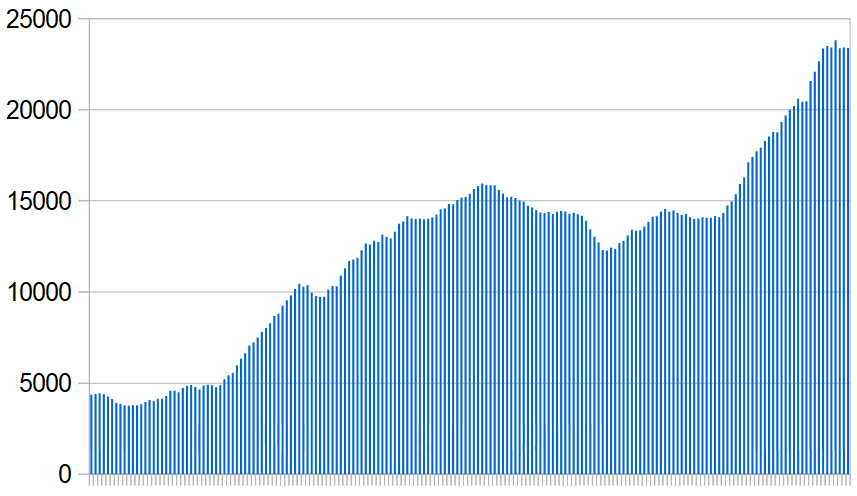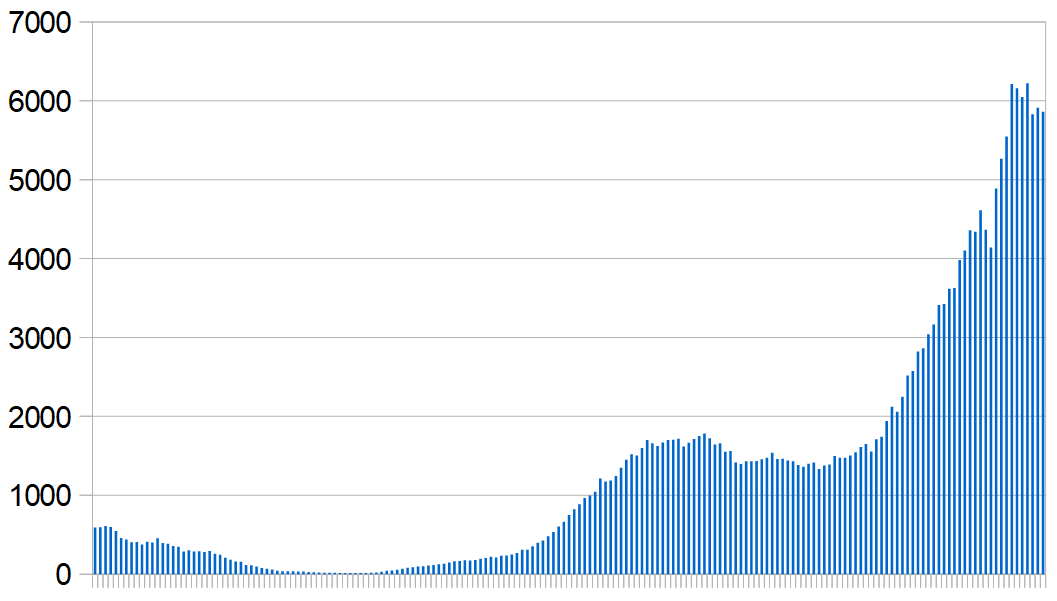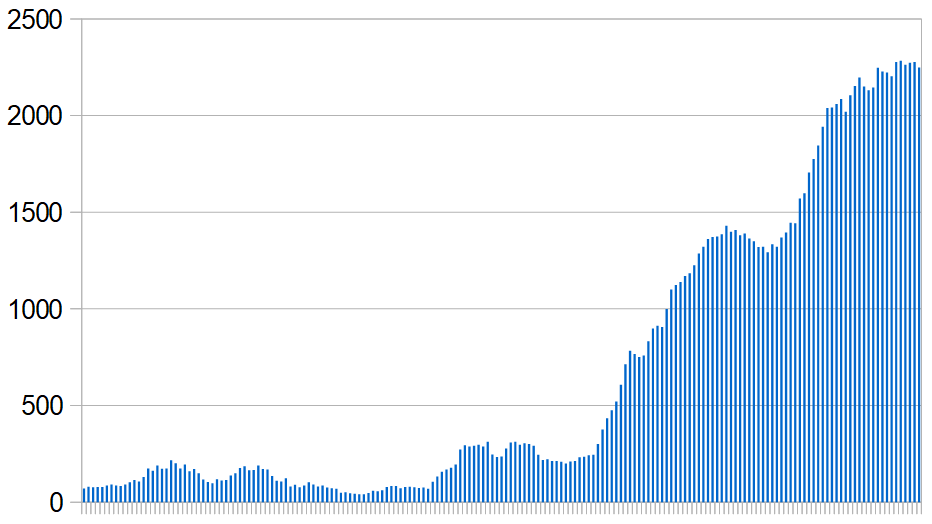Week ending 3 October 2020
REGIONAL OVERVIEW
 |
Almost 2.4 million Covid-19 infections have now been recorded in the Middle East and North Africa and the situation has worsened considerably over the past month.
New cases, which were averaging around 15,000 a day across the region at the start of September, are now averaging more than 23,000 a day. However, this week's figures suggest the rate of increase may be slowing.
Most countries in the region took swift action when the virus first arrived and for a while seemed to be having some success in slowing its spread. Six months on, though, many of them are struggling to hold the line, partly because of the economic effects of preventive measures.
Over the last four weeks Israel has seen by far the biggest rise in numbers of new cases, followed by Iran, Tunisia and Morocco. Saudi Arabia has reported a substantial decrease.
Overall, the coronavirus situation in the Middle East is evolving more slowly than during the earlier stages of the pandemic, so these regional updates will now appear monthly rather than weekly. Significant developments in individual countries will be covered in regular blog posts. The statistical spreadsheet, based on official figures from around the region, will continue to be updated daily.
Previous situation reports: September 26; September 19; September 12; September 5; August 29; August 22; August 15; August 8; August 1; July 25; July 18; July 11; July 4; June 27; June 20.
ALGERIA
Algeria's outbreak peaked towards the end of July when more than 600 new infections were being recorded each day. Since then the trend has been downwards, with new cases averaging 156 a day during the past week according to official figures.
For more information see: Covid-19 in Algeria
Confirmed cases: 50,847
New cases in past week: 1,093
Active cases: 13,713
Deaths: 1,749
Tests carried out: (unknown)
BAHRAIN
New cases reached a peak in mid-September but the numbers have been declining since then. This week's average was 516 new cases a day.
Bahrain has recorded more than 41,000 cases per million inhabitants. This makes it the world's second most infected country after Qatar. However, Bahrain is also one of the world leaders in Covid-19 testing. So far, about two-thirds of its 1.7 million population have been tested.
For more information see: Covid-19 in Bahrain
Confirmed cases: 71,803
New cases in past week: 3,613
Active cases: 5,364
Deaths: 255
Tests carried out: 1.5 million
EGYPT
According to the Egyptian authorities, new infections this week averaged 120 a day compared with almost 1,600 a day at the peak in June. The official figures are surprisingly low considering Egypt's large population (103 million) and the often crowded living conditions.
It's also unclear how many tests are being carried out because the government has not issued any figures since May when the total stood at 135,000 tests.
Further measures were announced this week to support the economically important tourism sector:
- Visa fees for tourists visiting South Sinai, the Red Sea, Luxor and Aswan are waived until April 30 next year.
- Hotels and other businesses in the tourism industry will not have to pay electricity, water or gas bills until December 31.
- Debts owed by companies in the tourism sector will be rescheduled, with no payments due until January 1.
- Discounted airport fees for airlines, which were due to end on October 31, are now extended until December 31.
Reuters reported this week that Russia has agreed to supply Egypt with 25 million doses of its Sputnik V coronavirus vaccine. Russian authorities licensed the vaccine for use in August, though large-scale human trials are not yet completed.
For more information see: Covid-19 in Egypt
Confirmed cases: 103,466
New cases in past week: 841
Active cases: (unknown)
Deaths: 5,956
Tests carried out: 135,000
IRAN
Iran was the first country in the region to be seriously affected by the virus. Government figures show an initial wave of infections which peaked at the end of March. It subsided during April, briefly dipping below 1,000 new cases a day but then rose again. This week's average was 3,531 a day – the highest level so far.
Iran continues to report more coronavirus-related deaths than any other country in the region.
Confirmed cases: 464,596
New cases in past week: 24,714
Active cases: 52,765
Deaths: 26,567
Tests carried out: 4.1 million
IRAQ
Iraq's official figures are widely believed to understate the scale of the epidemic. Many cases go unreported because of social stigma. Compliance with preventive measures appears to be low and health services are inadequate.
For the last four weeks new cases have been averaging more than 4,000 a day. This week's average was 4,366 a day – a small increase on the previous week's figure.
For more information see: Covid-19 in Iraq
Confirmed cases: 372,259
New cases in past week: 30,560
Active cases: 63,157
Deaths: 9,298
Tests carried out: 2.3 million
ISRAEL
 |
After coming close to bringing the epidemic under control, Israel has been hit by a second wave much larger than the first. The first wave peaked at around 600 new cases a day in early April. Efforts to control it were intially successful and by the second half of May new cases had dropped to about 15 a day.
However, the virus surged back when lockdown restrictions were lifted and the level of new infections continues to rise, this week hovering around 6,000 a day. Israel's infection rate is the highest in the region.
On September 18 Israel began its second nationwide lockdown, which is due to last for three weeks. Full details of the rules are here. Prime minister Binyamin Netanyahu said on Thursday that if the current lockdown does not reduce the spread of the virus "we will need to tighten it".
The lockdown is taking place amid disagreements about the way forward, plus considerable resistance from the public – especially religious elements.
Tourism minister Asaf Zamir (a member of the Blue and White alliance) resigned on Friday, saying: “I’m afraid Israel is on the brink of total catastrophe and it won’t change while Netanyahu is prime minister. The Covid crisis is at best at second place on his list of priorities.”
Confirmed cases: 258,920
New cases in past week: 41,021
Active cases: 72,165
Deaths: 1,633
Tests carried out: 3.6 million
JORDAN
For several months Jordan appeared to be the most successful Arab country in controlling the virus. Local transmission had virtually ceased and almost all the new cases were detected among people arriving from abroad.
Since then, however, local transmission has returned on a large scale and on Wednesday a record 1,776 new infections were reported. Those included 600 infections among workers at a factory in Zarqa.
Amjad Adaileh, the media affairs minister, warned on Thursday that the coronavirus situation has reached a “very dangerous” level.
The government is seeking to avoid another nationwide lockdown but is imposing local lockdowns in heavily affected areas. Roya News reports that a further 28 schools suspended attendance and switched to distance learning this week as a result of new infections.
Customers of cafes and restaurants can be served indoors again, following a government decision this week. Indoor dining was suspended two weeks ago and the resumption is subject to strict precautions.
For more information see: Covid-19 in Jordan
Confirmed cases: 13,650
New cases in past week: 6,439
Active cases: 8,642
Deaths: 79
Tests carried out: 1.3 million
KUWAIT
New infections peaked in late May at just over 1,000 cases a day. The numbers have fluctuated since then, but have been declining during the last three weeks. New cases this week averaged 521 a day.
For more information see: Covid-19 in Kuwait
Confirmed cases: 106,087
New cases in past week: 3,646
Active cases: 7,574
Deaths: 615
Tests carried out: 754,000
LEBANON
 |
Political and economic turmoil, plus the devastating explosion in Beirut on August 4, have diverted attention from the coronavirus. Lebanon's outbreak, though still relatively small, is growing.
The level of new infections, which averaged 1,173 a day this week, has doubled since mid-September.
On Friday the imterior ministry announced a lockdown of 11 towns and villages which are regarded as virus hotspots. It is due to begin on Sunday and last for eight days.
For more information see: Covid-19 in Lebanon
Confirmed cases: 42,173
New cases in past week: 8,211
Active cases: 23,048
Deaths: 386
Tests carried out: 867,000
LIBYA
Libya is in its tenth year of internal conflict. The UN-backed Government of National Unity in Tripoli is challenged by Field Marshall Haftar's forces based in the east of the country. There are also numerous militias. This leaves the country ill-equipped to cope with a major epidemic.
In an update this week, the WHO commented: "While Covid-19 is spreading fast and numbers of confirmed patients are rising, there seems to be a lack transparency and communication to the people by the Libyan government."
Growing levels of insecurity, political fragmentation and weak governance have led to a deterioration of basic services, particularly in the health system. At least 28 health facilities have been damaged or closed by fighting and some have been attacked directly. According to the WHO, Dr Abdel-Moneim al-Ghadamsi, professor of surgery at Al-Khadra Hospital, was kidnapped ion 11 September. Another doctor, the only anaesthetic specialist in al-Mogrif Hospital's intensive care unit was attacked on 12 September by security personnel and resigned, leaving the hospital without intensive care services. Bani Walid General Hospital was closed on 8 September after the administrative building and the emergency department were vandalised and staff were attacked.
New infections this week averaged 632 a day, according to official figures. A recent UN report said the true scale of Libya's outbreak is likely to be much higher than the official figures indicate, partly because of low testing capacity and lack of contact tracing.
For more information see: Covid-19 in Libya
Confirmed cases: 35,717
New cases in past week: 4,427
Active cases: 14,813
Deaths: 570
Tests carried out: 213,000
MOROCCO
 |
By early June a strict lockdown had reduced new cases in Morocco to around 40 a day. Since then, though, there has been a severe setback. New infections are running at record levels, though the rate of increase has recently slowed. This week's average was 2,249 new cases a day.
For more information see: Covid-19 in Morocco
Confirmed cases: 128,565
New cases in past week: 15,743
Active cases: 20,258
Deaths: 2,263
Tests carried out: 2.7 million
OMAN
New infections peaked in mid-July with just under 1,600 cases a day but dropped back sharply in August. They have risen again since, but not to previous levels.
Oman has not issued an update since September 29, when 529 new cases were reported.
For more information see: Covid-19 in Oman
Confirmed cases: 98,585 (no updates since September 29)
New cases in past week: 2,678
Active cases: 9,122
Deaths: 935
Tests carried out: 377,000
PALESTINE
The Palestinian enclave of Gaza is densely populated, with limited medical facilities, and there have long been fears about the likely consequences of a major epidemic. Until recently, however, Gaza had been relatively free of Covid-19, with only 117 confirmed cases.
That changed in the last week of August when 75 new cases were reported and the Hamas authorities imposed a lockdown. Transmission within the community has now clearly taken hold and this week saw a further 526 infections, bringing the total to 3,184.
Meanwhile, a further 6,555 new cases were reported in the West Bank this week.
Overall, the situation appears to be improving. The level of new cases has declined substantially since mid-September.
For more information see: Covid-19 in Palestine
Confirmed cases: 51,607 (West Bank 37,582, Gaza 3,184, East Jerusalem 10,841)
New cases in past week: West Bank 2,277; Gaza 526
Active cases: 8,683
Deaths: 379
Tests carried out: 426,000
QATAR
In population terms Qatar has more known cases than any other country – 44,000 per million inhabitants. Migrant workers have been disproportionately affected. Qatar's epidemic reached a peak in the first week of June but infections have fallen since then. New cases this week averaged 216 a day – well below the peak of more than 1,800 a day.
For more information see: Covid-19 in Qatar
Confirmed cases: 126,164
New cases in past week: 1,514
Active cases: 2,841
Deaths: 215
Tests carried out: 786,000
SAUDI ARABIA
 |
Saudi Arabia has the largest number of recorded cases among the Arab countries. New infections reached an initial peak in the fourth week of May, then dropped back slightly before rising to a higher peak in the third week of June. Since then, though, there has been a substantial improvement.
New cases showed a futher decline this week, averaging 464 a day – the lowest level since mid-April.
For more information see: Covid-19 in Saudi Arabia
Confirmed cases: 335,578
New cases in past week: 3,249
Active cases: 10,407
Deaths: 4,823
Tests carried out: 6.6 million
SUDAN
The coronavirus struck Sudan in the midst of a political transition following a popular uprising against the regime of President Bashir and the country is ill-equipped to cope with a major epidemic. Testing is very limited and official figures don't reflect the full scale of the outbreak. The health ministry appears to have stopped issuing daily reports.
For more information see: Covid-19 in Sudan
Confirmed cases: 13,653
New cases in past week: 61
Active cases: 6,053
Deaths: 836
Tests carried out: (unknown)
SYRIA
According to official figures only 4,289 cases have been recorded in areas controlled by the Assad regime.
The authorities' lack of transparency fuels suspicions that many cases are being concealed. There is also some evidence that people with Covid-19 symptoms are reluctant to contact the authorities. While there are plenty of signs that the true figures are higher than those issued by the regime, it is unclear how high they really are.
Last month the Covid-19 Response Team at Imperial College London issued a 46-page report which estimated that only 1.25% of Covid-related deaths in Damascus during July and August were officially reported.
According to the Assad regime, since the outbreak began there have been 203 deaths in areas that it controls. An alternative view can be found in this Twitter thread.
For more information see: Covid-19 in Syria
The following figures relate to regime-controlled areas only:
Confirmed cases: 4,289
New cases in past week: 288
Active cases: 2,956
Deaths: 203
Tests carried out: 26,572 (by 24 August)
TUNISIA
In June, Tunisia appeared to be almost free of the virus and began promoting itself as a safe holiday destination. Since then, though, there has been a setback and new infections this week averaged 761 a day.
For more information see: Covid-19 in Tunisia
Confirmed cases: 19,721
New cases in past week: 5,329
Active cases: 14,418
Deaths: 271
Tests carried out: 239,000
UNITED ARAB EMIRATES
The UAE's epidemic peaked in the last week of May when new infections were running at more than 900 a day. Numbers of new cases declined through June, July and August but have been rising again recently. This week's average of 998 a day matches the previous peak in May.
The UAE has carried out more tests per head of population than any other Arab country and ranks twelfth worldwide in terms of tests carried out.
For more information see: Covid-19 in the UAE
Confirmed cases: 96,529
New cases in past week: 6,989
Active cases: 10,034
Deaths: 424
Tests carried out: 9.9 million
YEMEN
Because of the ongoing war, Yemen already faced a humanitarian crisis before the coronavirus arrived. Millions are malnourished and vulnerable to disease, and health services are inadequate.
There have almost certainly been a lot more Covid-19 cases than the 2,000 shown by official figures. It's difficult to get tested for Covid-19 in Yemen and because of social stigma attached to the disease there are also many people who don't want to be tested.
However, fluctuations in the figures suggest the outbreak peaked in May and June. Since then the daily number of officially-reported new cases has dropped to single figures.
This is contrary to expectations because preventive measures have been minimal. However, anecdotal evidence supports the view that Yemen's epidemic has declined very substantially.
This has led to the suggestion that previous exposure to other diseases may have given Yemenis some protection against the coronavirus. Diseases that are rare in better-off countries, such as cholera, diphtheria, dengue fever and chikungunya, are common in Yemen.
For more information see: Covid-19 in Yemen
Confirmed cases: 2,043
New cases in past week: 11
Active cases: 144
Deaths: 589
Tests carried out: (unknown)

 RSS Feed
RSS Feed
